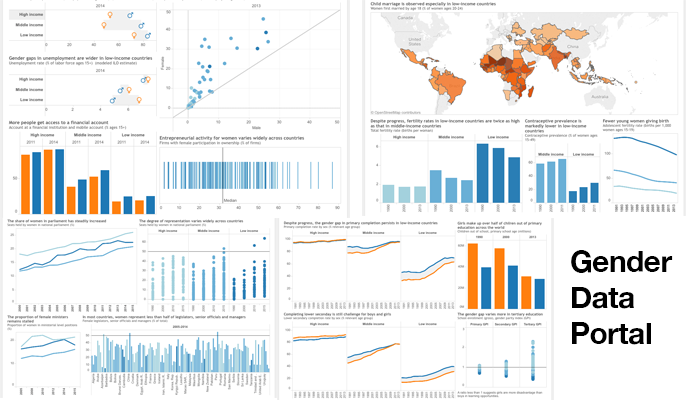The World Bank Group has just launched a new gender data portal that brings together sex-disaggregated and gender-relevant data on topics ranging from education, demographics, and health to jobs, asset ownership, and political participation. We’ve also just released the Little Data Book on Gender 2016 along with online tables that are linked to the latest data available in the World Development Indicators.
Gender data are one of the most visited parts of our data site, and these new resources make it easier than ever to see our data’s gender dimensions. The country and topic dashboards give an overview of the distribution and trends in data across important themes, and the online tables and book are a useful reference for the most commonly accessed data.
Below I’ve picked a few charts from the new portal related to the four pillars of the Bank Group’s new gender equality strategy. These aims focus on improving human endowments, through better access to health, education, and social protection; opening up more and better jobs by tackling issues such as skills gaps and care arrangements; expanding women’s access to and control over assets; and enhancing women’s voice and agency, meaning their ability to make themselves heard and exert control over key aspects of their own lives.
1) The education gap is largest in low-income countries
As of 2013, the worldwide primary school completion stands at an all-time high of 92.3%, a 13% increase since 1990. While this is great progress overall, completion rates remain substantially lower in low-income countries, and boys continue to complete primary school at a rate 10% higher than girls.
2) Women are more often unemployed and working without pay
Globally 50% of women participate in the labor market compared with 77% of men. From legal restrictions on employment to inadequate career and care options, a number of barriers see women’s unemployment rates higher than those of men across all income groups. Similarly, as shown in the chart below, the share of women who work in family-run businesses without pay is also higher in the majority of countries.
3) Women lag men in holding financial accounts in low and middle income countries
Globally, the percentage of women with an account at a financial institution went up from 47% in 2011 to 58% in 2014. But gaps in the relative proportion of men and women with access persist, especially in low- and middle-income countries.4) On average, women have a stake in a third of firms worldwide
In many countries, women face legal and social barriers that prevent them from owning or inheriting assets. Almost a third of firms worldwide have an element of female ownership, and in more than 20 countries, including China, Brazil, and Vietnam, more than 50% of firms have some female ownership.These are four of the charts that stood out for me in the new gender data portal, and I encourage you to take a moment to check it, out and let us know what you think!




Join the Conversation